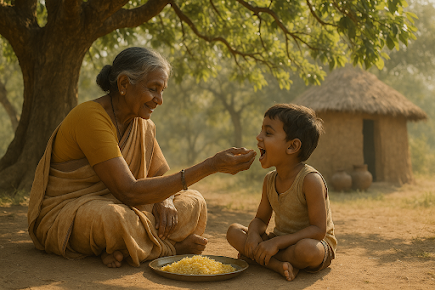Lost Legends of the Indian Kitchen: Desi Superfoods You Forgot (And Why You Desperately Need Them Back)

Intro: What If the Cure Was in Your Grandma’s Spice Box All Along?
You probably walk past them every day in the market—ragi, amla, makhana, moringa—just old-fashioned ingredients collecting dust on shelves, while you toss trendy “superfoods” like chia seeds, quinoa, and kale into your shopping cart.
But what if I told you that these desi gems are not only cheaper but more powerful than many imported health trends? What if I told you that our obsession with processed foods and imported nutrition fads is silently erasing ancient wisdom—and with it, our health?
In this blog, we dive deep into the Indian superfoods we’ve forgotten, the diseases that have risen in their absence, and the shocking data proving why it’s time to bring them back—on our plates, in our kitchens, and in our lives.
Chapter 1: What Are Superfoods—And Why Did We Forget Ours?
“Superfood” is just a buzzword today—marketed by brands to push expensive health powders and exotic berries. But if you look closely, India was always the OG superfood capital. We had the wisdom of Ayurveda, the balance of local seasonal produce, and the nutrient density of whole foods. So what happened?
🤯 The Shift That Broke Us:
-
White rice replaced millets.
-
Refined wheat took over coarse grains.
-
Carbonated drinks pushed out buttermilk.
-
Processed chips won over roasted chana.
This wasn’t just cultural erosion. It was a nutritional collapse.
Disease Explosion:
-
Type 2 diabetes in Indian youth has doubled in the past 15 years.
-
1 in 3 Indians is now overweight or obese.
-
Lifestyle diseases (once called “rich man’s diseases”) are now widespread, even in rural India.
We didn’t just forget our food—we invited sickness in by embracing the shiny but hollow replacements.
Chapter 2: Meet the Forgotten Heroes of Indian Food
Here’s a list of powerful desi superfoods that were once staples in Indian households—and why science says they deserve a comeback.
🌾 Ragi (Finger Millet): The Bone Builder
-
Rich in calcium (3x more than milk!), iron, and fiber
-
Gluten-free and diabetic-friendly
-
Keeps you full for long hours—great for weight loss
🩺 Health Impact: Prevents osteoporosis, reduces sugar spikes, aids digestion
🚫 Forgotten Because: Replaced by polished rice and wheat for convenience
🟡 Turmeric: The Golden Healer
-
Contains curcumin—anti-inflammatory, antioxidant
-
Boosts immunity, heals gut, improves brain function
🩺 Health Impact: Fights chronic inflammation (linked to cancer, arthritis, heart disease)
🚫 Forgotten Because: Commercialized and stripped of traditional use (Haldi Doodh became “Turmeric Latte”!)
🍈 Amla (Indian Gooseberry): The Vitamin C King
-
20x more Vitamin C than oranges
-
Natural collagen booster, immunity enhancer
🩺 Health Impact: Improves vision, hair, digestion, and skin health
🚫 Forgotten Because: Too sour for modern palates; replaced by flavored Vitamin C tablets
🌿 Moringa (Drumstick Leaves): The Multivitamin Tree
-
Rich in calcium, iron, potassium, amino acids
-
Detoxifies the liver and controls blood sugar
🩺 Health Impact: Fights anemia, controls cholesterol, protects liver
🚫 Forgotten Because: Viewed as “poor people’s food”
🌰 Makhana (Fox Nuts): The Low-Calorie Snack
-
High in protein, low in fat
-
Antioxidant-rich, ideal for heart health
🩺 Health Impact: Helps manage weight, supports kidney health
🚫 Forgotten Because: Overshadowed by Western snacks like popcorn and chips
Chapter 3: What Happens When We Replace Superfoods with Junk?
Let’s break it down.
| Superfood | Replaced By | Impact |
| Ragi | White bread/rice | Blood sugar spikes, poor satiety |
| Amla | Sugary juices | Weaker immunity |
| Moringa | Processed protein powders | Poor liver & blood health |
| Makhana | Packaged chips | Weight gain, high sodium |
| Turmeric | Painkillers & supplements | Ignored inflammation causes |
-
Early Diabetes: Found in children as young as 9
-
PCOS & Hormonal Disorders: Now common in teenage girls
-
Depression & Fatigue: Linked to poor gut health, which superfoods actually support!

Chapter 4: Urban Myths That Killed Our Superfoods
Let’s bust some myths:
❌ “Millets are for old people.”
✔️ Reality: Millets are smart carbs—great for working professionals, athletes, and children.
❌ “Desi food takes too long to make.”
✔️ Reality: Makhana can be roasted in 5 mins, ragi dosa in 10.
❌ “Imported food = better nutrition.”
✔️ Reality: Most Indian superfoods outperform their foreign counterparts in every nutrient chart.
Chapter 5: How to Bring Them Back (Without Changing Your Life)
-
Start Small: Swap one meal a day (e.g., breakfast oats → ragi porridge)
-
Snack Smart: Ditch chips, eat roasted chana or makhana
-
Spice Right: Use turmeric and amla juice during season change
-
Go Seasonal: Moringa sabzi in winters, amla pickle year-round
-
Educate Kids: Share fun facts about these foods with children
Chapter 6: What Our Ancestors Got Right
Before hospitals, before supplements, before fad diets—there was seasonal eating, balanced thalis, fermented foods, and natural medicine. We’re not saying turn your kitchen into an Ayurvedic clinic—but maybe listen to your dadi once in a while.
What if the real “super” foods weren’t on foreign shelves, but right in your backyard?

Final Thoughts: It’s Not Just Food, It’s Identity
We’ve forgotten more than just flavors—we’ve lost memories, health, and cultural pride. But the best part? It’s all still here, waiting to be rediscovered.
So the next time someone tries to sell you a miracle supplement, maybe look inside your own kitchen first. Chances are, your body—and your heritage—will thank you for it.
Call to Action:
Have you tried ragi or amla recently? Planning to reintroduce a desi superfood in your home? Tell us in the comments below 👇
And don’t forget to share this blog with someone who still thinks quinoa is better than rajgira.
Comments
Post a Comment